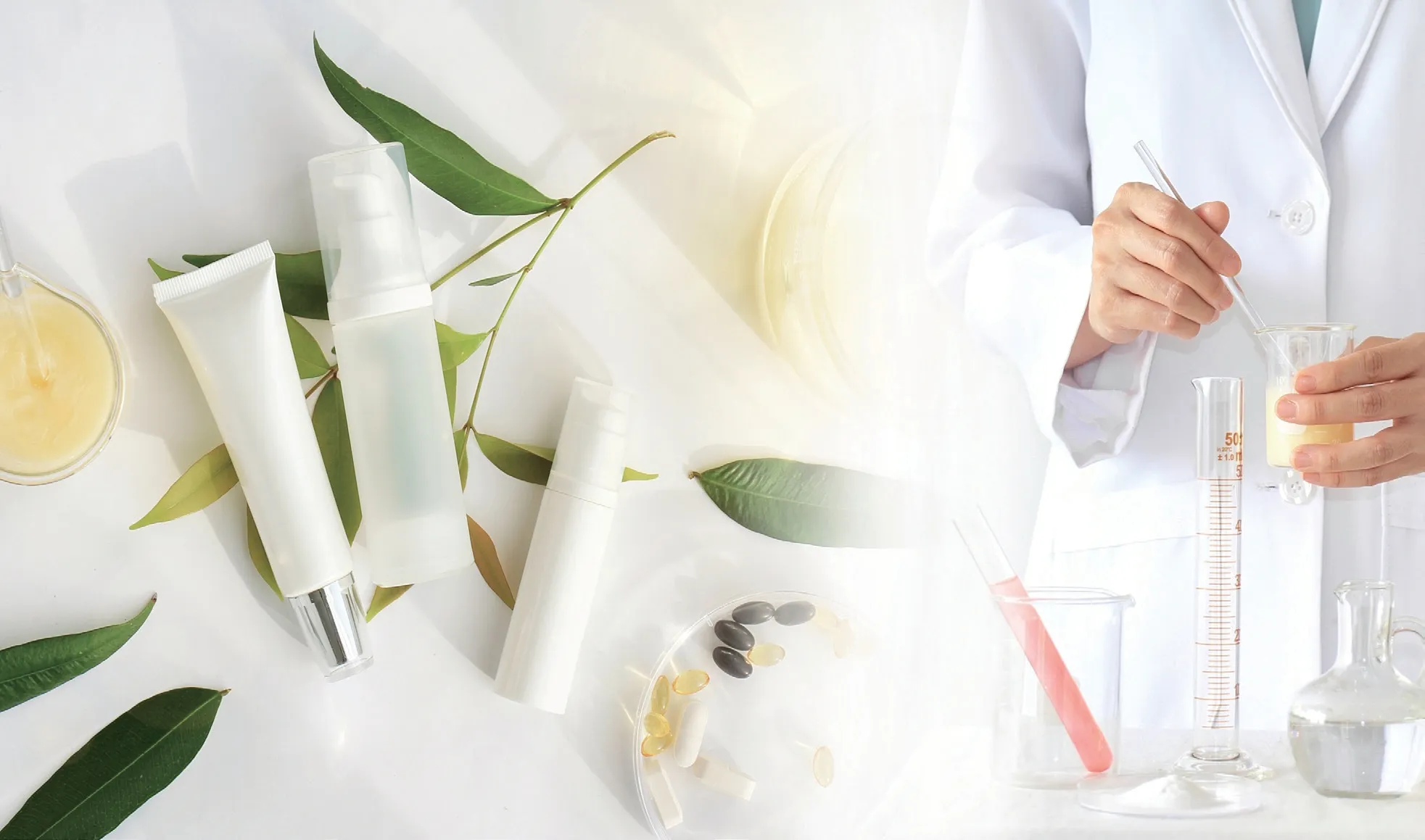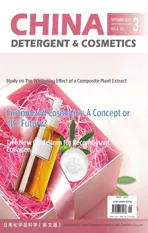Physicochemical Properties,Polysaccharide Composition Analysis and Efficacy Evaluation of Narcissus Tazetta Extract
2023-11-29HsiaoTzuChihPanFawuWangXiliGaoYuanyuanLinXiaofeng
Hsiao TzuChih,Pan Fawu,Wang Xili,Gao Yuanyuan,Lin Xiaofeng
Juwenlee Cosmetics Technology Center,LUO LIH-FEN Group,China;
Chyau CharngCherng
Research Institute of Biotechnology,Hung Kuang University,China Fund projects: Fujian Provincial Foreign Cooperation Project of Science and Technology Plan (Project No.: 202 111010)
Abstract Numerous literature has reported that polysaccharides-based cosmetics present multifunctional effects in skin moisturizing for protecting the skin barrier.The aim of this study is to investigate the physicochemical properties,purities,composition and cellular functions of polysaccharides extracted from the bulb of Narcissus tazetta var.chinensis (NBP) and to evaluate its efficacy evaluation on skin moisture,elasticity,allergies and inflammation. The polysaccharides were obtained from the Narcissus tazetta bulb by using cold water extraction and ethanol precipitation methods.The residual impurities,polysaccharides molecular weight and composition were analyzed by UV spectrophotometry,gel chromatography,high performance liquid chromatography and infrared spectroscopy;skin hydration and elasticity assay were analyzed following efficacy evalution on human body;laboratory test was used to evaluate histamine and nitric oxide (NO) activity.The results indicate that a yield of 6% (w/w) of NBP,show that the NBP does not contain starch,protein,colchicine,lycorine,etc.,The average molecular weight of NBP is 559 kDa,and is composed of mannose and glucose,n(mannose) : n(glucose)=4:1.0.5% NBP can increase skin hydration and elasticity assay on human body.The NBP is non-cytotoxic,in the basophils RBL-2H3 cell model tests,NBP concentrations at 100~250 μg/mL can effectively inhibit the release of histamine,and the NBP concentrations 600~1000 μg/mL can significantly inhibit LPS-induced NO production in RAW264.7 cells which are showed dose-responsive effects.These findings demonstrate that the NBP prepared in the study could offer potent skin protection,preserving hydration and elasticity,while also providing anti-allergy and anti-inflammatory properties. It can,therefore,be considered an excellent candidate for polysaccharide-based cosmetics.
Key words hydration;elasticity;histamine;nitric oxide
With the continuous development of the economy and the increased standard of living in China,skin care cosmetics have gradually changed from being an occasional luxury to being a daily necessity,becoming a crucial part of one’s daily routine. During a period of continuous progress in chemical synthesis technology,cosmetics mainly contained synthetic chemical ingredients,but the concurring problems with toxicity,allergies,and irritation of chemical products,have raised concerns by many people.In addition,the chemical industry has caused environmental problems,so consumers have begun to pursue natural and non-toxic products.At this time,plant-derived cosmetics are valued and sought after by people.In recent years,even major international brands have launched plant-based cosmetics.Plant-based cosmetics use plant components in the products,including plant extracts.After separation,plant extracts and appropriate substrates are obtained and added to cosmetics.At present,sales of cosmetics using plant extracts as raw materials are showing an upwards trend.Narcissus tazetta was a prolific flower,commonly found in China,spanning many provinces,including Fujian.In recent years,,except for a small amount of planting on Chongming Island in Shanghai,the production of Narcissus tazetta var.chinensis is almost exclusively in Fujian Province.N.tazetta bulb is not only regarded as the provincial flower of Fujian Province,but also the city flower of Zhangzhou City,which is the main region of production. Currently,Narcissus Tazetta Bulbs are mainly used for decorative purposes.However,if new applications for N.tazetta bulbs are developed,it could give legitimacy to growing the flower as a crop,providing income to flower farmers and developing the flower market throughout the country.Studies have found that the content of alkaloids in N.tazetta bulbs are very low.The content of colchicine is less than 10 mg/kg,and the content of lycorine is only 0.02%~0.05%,while the content of viscous polysaccharides Narcissus tazetta var.chinensis (NBP)is higher,reaching 4.5%[1,2].Preliminary data indicate that the NBP mucilage presented significant effects on moisture and elasticity in skin.It contains a certain degree of anti-allergy properties,and by reducing histamine,can strengthen immunity[3]and inhibit inflammatory reactions.As an important inflammatory factor,nitric oxide (NO) has certain tissue and cytotoxicity.It can cause oxidative damage,cell degeneration and tissue adhesion,thereby aggravating an inflammatory response.Therefore,inhibiting the secretion of NO by macrophages is one of the important methods for preventing inflammation[4].
In addition to the common antioxidant,anti-aging and moisturizing properties of cosmetics,NBP is also anti-allergic and anti-inflammatory.It is safe and reliable for people with sensitive skin and has no toxic side effects[5].These properties meet the functional needs of cosmetics and biomedical products,giving the plant enormous potential value and broad market appeal.
1 Materials and methods
1.1 Main reagents and instruments
Samples included fresh Narcissus tazetta bulbs[6](Omics Lifescience Co.,Ltd.,Zhangzhou City,Fujian Province);methanol (Sigma Company);dextran reference substance (Shanghai Aladdin Company);rat RBL-2H3 cell line (Shanghai Fuxiang Company);mouse RAW264.7 cell line (Shanghai Cell Institute,Chinese Academy of Sciences);histamine kit(Beiyuntian Company);NO detection kit (Beiyuntian Company);MTT reagent (Sigma Company);calf serum (Gibco Company,USA) ;Trypsin (U.S.Hyclone Company).Experimental instruments include high-performance liquid chromatography LC-16,PDA detector (Shimadzu Corporation of Japan);ultraviolet-visible spectrophotometer U-T1810DPC(Shanghai Yupu Corporation);gel permeation chromatography Breeze (U.S.Waters Corporation);skin Tester Cotometer MPA-10 (Courage Khazaka,Germany);carbon dioxide incubator MC0-15AC(Thermo Fisher);multi-functional microplate reader Multiskan G0 (Thermo Fisher);freeze dryer FD-2D(Beijing Boyikang Company) .
1.1.1 Preparation method of NBP
To begin,1 kg of fresh Narcissus tazetta bulb polysaccharide (NBP) was prepared by peeling off the skin,cutting off the roots,and rinsing with water;the washed Narcissus bulbs and the aqueous solution containing preservatives and hydrolase inhibitors were poured into a blending machine for continuous mixing and stirring;the solution was then rinsed with 2 kg of 80% alcohol at 25 °C for 90 min,and rinsed a second time;the residue was extracted with 4 kg of pure water at 5 °C~10 °C for 120 min,again,it was rinsed twice.The extract was added to 0.01%polyaluminum chloride solution to flocculate for 12 h.The supernatant and bottom sediment were filtered through a filter cloth,and then stirred. Finally,the pH was adjusted to lessen acidity,and then concentrated in a vacuum;the concentrated solution became the alcohol precipitate[7].
1.1.2 I2/KI test identification
Pure water was used to prepare the freeze-dried NBP into a 5 mg/mL solution. The NBP solution was boiled and cooled,and then it was pipetted with 0.001% starch solution.We then added 0.5mL I2/KI(2.5 g I2/5.0 g KI/100 mL pure water) to each solution in the colorimetric tube,mixed well,and observed the color change.
1.1.3 Coomassie brilliant blue test
Coomassie brilliant blue G-250 method[8]:5 mg/mL NBP solution was prepared with pure water;took 1.00 mL NBP solution and pure water into the colorimetric tube;then added 4.00 mL staining solution (0.01% Coomassie brilliant blue-250);shook well and observed the color.
1.1.4 Ultraviolet spectrophotometer detection
Used pure water to make a 5 mg/mL NBP solution;took a little sample and added to the cuvette;put the cuvette into the UV spectrophotometer;scanned the range of 200~ 400 nm absorption of ultraviolet light.
1.1.5 Molecular weight determination
The molecular weight determination of NBP was done according to the previous method[9].The instrument configuration is Breeze high-performance gel permeation chromatograph (Waters 2410 differential refractive index detector,TSK G-5000 PWXL gel column).The instrument conditions were:the mobile phase is 0.02 mol/L KH2PO4solution,the flow rate is 0.6 mL/min,and the column temperature is 40 °C.
1.1.6 Pre-column PMP derivatization analysis of monosaccharide composition
Experimental method reference[10]: The sample was firstly hydrolyzed with trifluoroacetic acid and an oxygen-barrier at high temperature;The trifluoroacetic acid was removed by vacuum rotary evaporation.The volume was fixed with a phosphate buffer,and filtered through a microporous filter.The filtrate was then taken for analysis.
1.1.7 Infrared spectroscopy analysis
NBP (2~5 mg) was mixed with 0.50 g dry KBr and was ground with a mortar until the particle size of the material was less than 200 meshes.The tablet of NBP was made under a pressure of 15~20 MPa for the analysis of infrared spectrometry with scanning ranges of 4,000 to 500 cm-1[11].
1.1.8 Test skin hydration and elasticity assay
The skin hydration (%) and elasticity assay(%) were tested to evaluate the moisturizing effect of 0.5% NBP twice daily over a period of 4 weeks.The hydration experimental method referred to the "Guidelines for the Evaluation of Cosmetic Moisturizing Efficacy-Non-aqueous System QB/T,256-2011".The multifunctional skin tests with Dual-MPA 580 Corneometer (Courage+Khazaka electronic GmbH,Germany) were used to determine the skin hydration.The Dual-MPA 580 Cutometer were used to determine the skin elasticity assay respectively.The number of volunteers was 20,aged 20~60 years old,and each volunteer washed her face uniformly and wiped it dry.We drew 2 mg/cm2for 3 test areas on each volunteer’s face: right cheek,left cheek and forehead.Each test area was a randomized test sample,and after samples were taken,the volunteers remained in the controlled test environment,ensuring their test patches were stable.The temperature of the environment was 25±2 ℃,the relative humidity of the environment remained at 40%~60%.Once stabilized,they applied (2.0±0.1) mg/cm2of 0.5%NBP to each area.The skin hydration and elasticity assay of each tested area were measured at wk1,wk2,wk3 and wk4,respectively.
1.1.9 Anti-allergy method to detect the histamine release effect of NBP
Firstly,the cell culture used RPMI-1640 medium(containing 10% fetal bovine serum,100 u/mL penicillin,100 u/mL streptomycin) to culture rat basophils RBL-2H3,culture at 37 ℃,5% CO2,and count 5×105cells were placed in one well of a 6-well cell culture plate and passaged every 2 to 3 days.The sensitized RBL-2H3 cells were recovered by trypsin digestion,suspended in RPMI-1640 medium and diluted to 106 cells/mL,200 μL per well was added to a 48-well plate,and 200 ng/mL anti-DNP-IgE was added at the same time.It was incubated overnight in an incubator (37 ℃,5% CO2).Washed the wells with PBS for the stimulation cells 3 times,dissolved NBP in 200 μL PBS buffer,added them to the culture plate according to different concentrations (20,50,100,150,200 μg/mL),added 200 μL PBS to negative wells,Continue to cultivate for 1h.Finally,the histamine test was performed.RBL-2H3 cells were stimulated with 500 ng/mL DNP-BSA for 15 min,and the cell culture supernatant was recovered.The histamine content in the cell supernatant was detected according to the operating instructions of the IBL Histamine[12,13].
1.1.10 Griess method to detect the NO release effect of NBP
According to Li Yanhong's research[14],while making appropriate adjustments,collected the RAW264.7 cells in the logarithmic growth phase,pipetted evenly,and inoculated the cells in a 48-well plate at 2.5×105cells/well.The experiment was divided into a blank control group,LPS group,and NBP group.Each group was tested three times.The NBP group was set with three concentration gradients,and LPS was added to the final concentration of 1 μg/mL and incubated for 24 h.After 24 h,the cell supernatant was collected.A nitric oxide detection kit was used to detect the NO content in the cell supernatant[15].
1.1.11 Ethics statement
We examined 20 healthy female volunteers (aged 20~60 years) with healthy skin.They had not applied any moisturizer or skin care products during the 4-week testing period.All subjects were informed about the details of the study and signed an informed consent form approved by the Institutional Review Board of the Technical Testing Center of Juwenlee (Fujian) Co.,Ltd.in China.Registration number is CNAS L12773,the protocol number is JWLYF2022-01.
1.1.12 Statistical analyses
All data were presented as the mean ± standard deviation (SD).For analyzing the two groups,statistics were performed using Student’s t-test (Sigma plot 10.0.Systat Software,Inc.,CA,USA).p values are indicated by asterisks as follows: *p<0.05 is considered significant,**p<0.01,***p<0.001.
2 Results
2.1 Preparation of extract of NBP
Based on the data of this research,we can roughly calculate the average weight of Narcissus tazetta bulb polysaccharide (NBP) to about 150 g,about which 9 g are polysaccharides.The polysaccharides can be extracted after vacuum drying at 45 °C for 12 h.The extraction rate is 6%,which is very valuable.
2.2 Impurity detection
In researching NBP,its properties are negative in the I2/KI test,meaning,the NBP does not contain starch.The Coomassie Brilliant Blue test was negative.Therefore,it does not contain protein.The ultraviolet absorption spectrum of the aqueous solution of NBP is shown in Figure 1.There was no obvious ultraviolet absorption at 220~300 nm.It is preliminarily determined that the NBP does not contain colchicine (absorption peak 244 nm) or lycorine (absorption peak 288 nm).Other natural compounds with chromophore groups have further confirmed that NBP has higher purity.

Figure 1. UV absorption spectrum of NBP (Left: Colchicine;Middle: Lycorine;Right: NBP)
2.3 The composition analysis liquid chromatogram of NBP
It is shown in Figure 2,Mannose’s retention time was 30.3 min and glucose’s retention time was 32.1 min.From the comparison and analysis of the spectrum,NBP was composed of mannose and glucose.Further calculated,the area ratio was 4∶1 by the peak.

Figure 2. Liquid chromatogram of polysaccharide composition analysis of NTBP
2.4.Relative molecular weight determination
The GPC spectrum of NBP is shown in Figure 3.Among them,the peak area of 11.307 min accounted for 94.6%,and its average molecular weight was 559 k Da,af ter GPC sof t ware processing.It can be seen that the NBP prepared in this experiment was a polymer compound.

Figure 3. GPC chromatogram of NBP
2.5 Infrared Spectroscopy Analysis
The infrared spectrum scanning result of NBP is shown in Figure 4.The stretching vibration of OH was 3,418 cm-1.The absorption band was very wide,indicating the hydrogen bond formed between -OH and -OH;The stretching vibration of CH had weak absorption at 2,923 cm-1;the stretching vibration of C=O in the ester functional group was 1,732 cm-1and peaks at 1,634cm-1.The peak was weak and broad,possibly because C=O and -OH are connected by hydrogen bonds and form a six-membered ring;the shear deformation vibration of CH3and CH2are 1,443cm-1and 1,372 cm-1respectively.The C-O-C stretching vibration was 1,237 cm-1in ester or ether;the O-C stretching vibration in alcohol hydroxyl group was 1,030 cm-1;the characteristic absorption of the mannose component was 804 cm-1and 874 cm-1.Among them,400~1,300 cm-1had typical infrared absorption characteristics of polysaccharides.In summary,the material isolated from the narcissus bulbs in the experiment were polysaccharides,and the polysaccharides had an ester group.

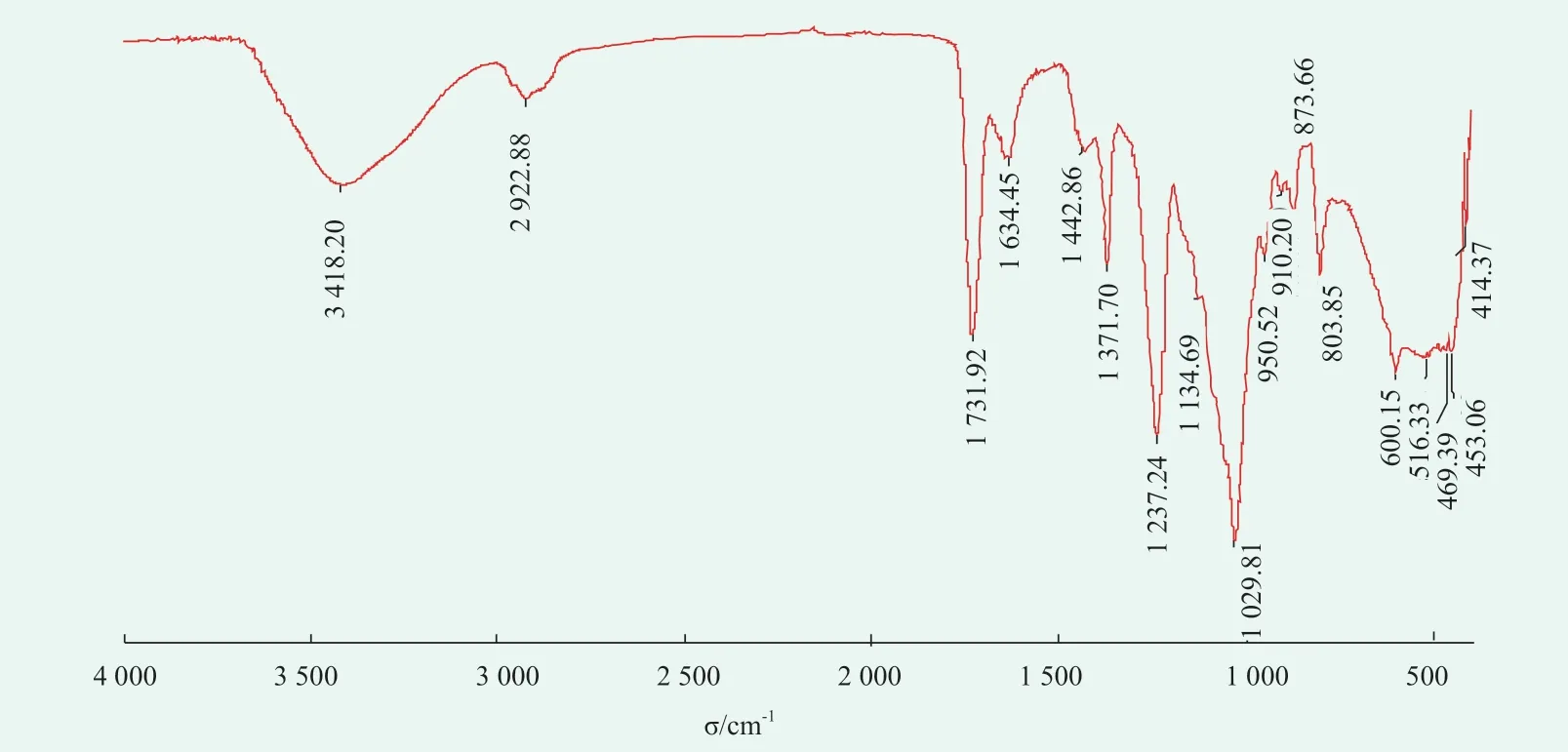
Figure 4. Infrared absorption spectrum of NBP
2.6 Test skin hydration and elasticity assay
In the skin hydration study,changes in skin hydration (%) increased in a time-dependent pattern and the maximum increase in skin humidity was reached on week2.For the left cheek,the changes in skin hydration (%) were as follows: 6.93%,9.20%,8.76% and 7.79% for week 1,week 2,week 3 and week 4,respectively.For the right cheek,the changes in skin hydration (%) were 6.20%,8.31%,8.56%and 8.15% for week 1,week 2,week 3 and week 4,respectively.For the forehead,the changes in skin hydration (%) were 5.92%,8.01%,7.54% and 7.58%for week 1,week 2,week 3 and week 4,respectively.The average changes in skin hydration (%) were 6.35%,8.51%,8.29% and 7.84% for week 1,week 2,week 3 and week 4,respectively (Figure 5).


Figure 5. The effect of 0.5% NBP on skin hydration
In the skin elasticity assay,changes in skin elasticity parameter R2(%) increased in a timedependent pattern and the maximum increase in skin elasticity parameter R2was reached on the week3.For the left cheek,the changes in skin elasticity parameter R2(%) were 1.24%,4.88%,9.08% and 8.59% for week 1,week 2,week 3 and week 4,respectively.For the right cheek,the changes in skin elasticity parameter R2(%) were 1.85%,6.89%,8.23% and 8.53% for week 1,week 2,week 3 and week 4,respectively.For the forehead,the changes in skin elasticity parameter R2(%) were 0.92%,6.44%,6.75% and 7.09% for week 1,week 2,week 3 and week 4,respectively.The average changes in skin elasticity parameter R2(%) were 1.34%,6.07%,8.02% and 8.06% for week 1,week 2,week 3 and week 4,respectively (Figure 6).

Figure 6. Effect of 0.5% NBP on skin elasticity
2.7 Cytotoxicity test by MTT method and Anti-allergy test of NBP
Firstly,different concentrations of NBP can promote the proliferation of RBL-2H3cells.The effect was most obvious at 100~250 µg/mL,which meant that the NBP was not cytotoxic (as shown in Figure 7).

Figure 7. Cell Viability test of NBP
Second,RBL-2H3 cells were sensitized by IgE,and RBL-2H3cells were stimulated with 500 ng/mL DNP-BSA for 15 minutes.The cell culture supernatant was then recovered,and the histamine content of the cell culture supernatant was detected by ELISA,according to the kit instructions.The histamine standard curve was prepared by operation,and the histamine content in the cell supernatant of different experimental groups was calculated.The results are shown in Figure 7.The histamine content in the cell supernatant of the negative control group was 26.8 ng/mL,and the positive control group is stimulated by DNP-BSA.The histamine release reached 132.3 ng/mL (p<0.01),and the histamine release of RBL-2H3cells treated with NBP with different concentration gradients (100 μg/mL,150 μg/mL,200 μg/mL,250 μg/mL) were 102.7 ng/mL,89.7 ng/mL,76.3 ng/mL,51.53 ng/mL respectively.Compared with the DNP-BSA group,there were significant differences. The inhibition rates were 22.37%,32.20%,and 33.26%,respectively,and they were concentration-dependent.From the experimental results,it can be seen that NBP can effectively inhibit the release of histamine mediators from RBL-2H3 cells.(as shown in Figure 8)
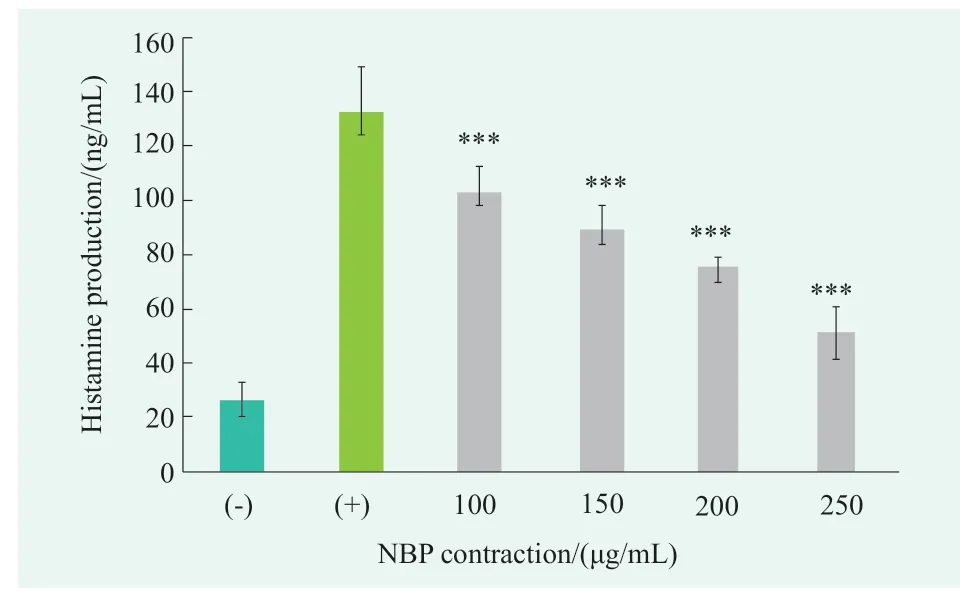
Figure 8. Anti-allergy test of NBP
2.8 Cytotoxicity test by MTT method and anti-inflammatory test
Firstly,Different concentrations of NBP can promote the proliferation of RAW264.7 cells.The effect was most obvious at 600~1,000 μg/mL,which means that the NBP was not cytotoxic (as shown in Figure 9).Second,as an important inflammatory factor,NO had certain tissue and cytotoxicity,which can cause oxidative damage,cell degeneration and tissue adhesion,thereby aggravating the inflammatory response,so inhibiting macrophage secretion of NO was an anti-inflammatory method[16].According to the NO detection instructions,the standard curve was drawn with the NaNO2concentration and OD540of the kit standard as the horizontal and vertical coordinates,and the regression equation of the standard curve was calculated.According to the detected OD540of the sample,the corresponding NaNO2concentration was calculated correspondingly,representing the NO concentration.Taking the average value of three replicate wells as the final NO detection results,the NO generation (%) of different concentration gradients of 600~1,000 μg/mL-1NBP is 87.7%,84.49%,80.75%,respectively.The results show,in 600~1,000 μg/mL,NBP can significantly inhibit LPS-induced NO production in RAW264.7 cells in a dose-dependent manner(as shown in Figure 10).

Figure 9. Cell viability of NBP

Figure 10. NO Release Effect of NBP
3 Discussion
At present,Narcissus tazetta var. Chinensisfrom Zhangzhou,Fujian is only commonly used as a decorative flower.If new uses of the polysaccharide ofNarcissus tazettabulb (NBP) can be developed,research has found that the polysaccharide content ofN. tazettabulb in Zhangzhou is higher than that of other N.Tazetta bulbs from other regions.Previous research has shown similar extraction rates,despite showing different molecular weights.The study found a total of 6.5% (w/w) of NBP,prepared by hot water extraction,from the N.tazetta bulb.The average molecular weight of NBP is 559 kDa,different from that of a previous report of 119 kDa[17].Based on our research,we calculated the average extraction weight of NBP for 150 g ofN. tazettaBulb to be about 9g(or 6%) of polysaccharides,which is very valuable.If the natural medicinal value of NBP is developed and used as a material for extracting biologically active substances,NBP can be marketed and sold as a commodity.In addition,NBP creates a medicinal use forN. tazettabulbs,used currently only as a decorative flower.Research shows that this plant has considerable potential.
The extraction methods of polysaccharides currently include water extraction,alcohol precipitation,enzyme-assisted method,supercritical extraction method,etc.Different extraction methods are suitable for different plants,and each method has its own advantages and disadvantages.The invention patent 2010105077001 “Method for Extraction and Separation of Chinese Narcissus Polysaccharides”provides a method for extracting and separating NBP.This method uses hot water extraction to extract polysaccharides fromN. Tazettabulbs,which will cause starch to be extracted and combined with polysaccharides,resulting in a large amount of gelatinous starch.Another study reported a process for extracting NBP.Firstly,ethanol/petroleum ether was used to remove lipids,and then lyophilized and crushed and then extracted with hot water.At the same time,a large amount of gelatinous starch was produced.The disadvantage of using hot water extraction is that polysaccharides are degraded in the process and the viscosity of the product is severely reduced.In summary,the current industrial production of NBP mainly involves complicated processes and high costs,and the products are mixed with starch,which is then difficult to separate from polysaccharides.Plant cells contain a large number of hydrolases in their vacuoles.If the hydrolases cannot be inactivated or removed in time,the high molecular weight polysaccharide will be quickly hydrolyzed to a low molecular weight.In addition,experiments have shown that high-temperature heating is not feasible because it causes hydrolysis and the stability of the polysaccharide enzyme degrades.
In summary,the current commercial production of NBP mainly involves complex processes and high costs.Experiments show that high temperatures used to extract the polysaccharide are not feasible because the polysaccharide enzymes become unstable and easily degrade,the viscosity is severely reduced,and the product is mixed with starch and is difficult to separate from polysaccharides.Narcissus tazetta bulbs contain a variety of alkaloids,which have inhibitory effects on cancer cells,but are very toxic to common cells.Therefore,to make cosmetic raw materials,the alkaloids in N.tazetta bulbs must be completely removed or the residual amount must be at a safe level.With 2 mg/cm2used on facial skin,the change of skin hydration and elasticity assay of NBP (within 4 weeks) can be seen in Figure 5 and Figure 6.It may be that the NBP applied on the surface of the skin forms a film that covers the surface of the skin and improves the skin hydration rate and elasticity.
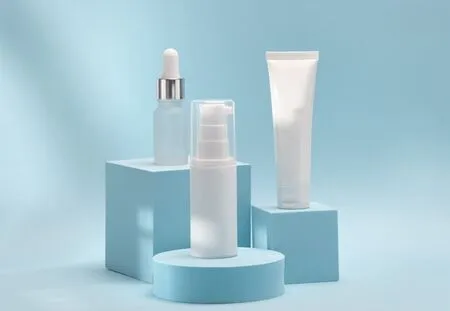
4 Conclusion
The test results show that Narcissus tazetta bulb extract provides high yield and high purity polysaccharide compounds.The 0.5% Narcissus tazetta bulb polysaccharide (NBP) can improve skin hydration and elasticity,which shows NBP has great potential in cosmetics.In addition,we used RBL-2H3cells to evaluate the anti-allergy activity of NBP.The results show that NBP significantly reduced the release of histamine.For the antiinflammation effect,NBP can reduce the production of NO in RAW264.7 cells.Therefore,the preliminary study indicates the potential application of NBP in the cosmetic industry for personal skin-care products.
